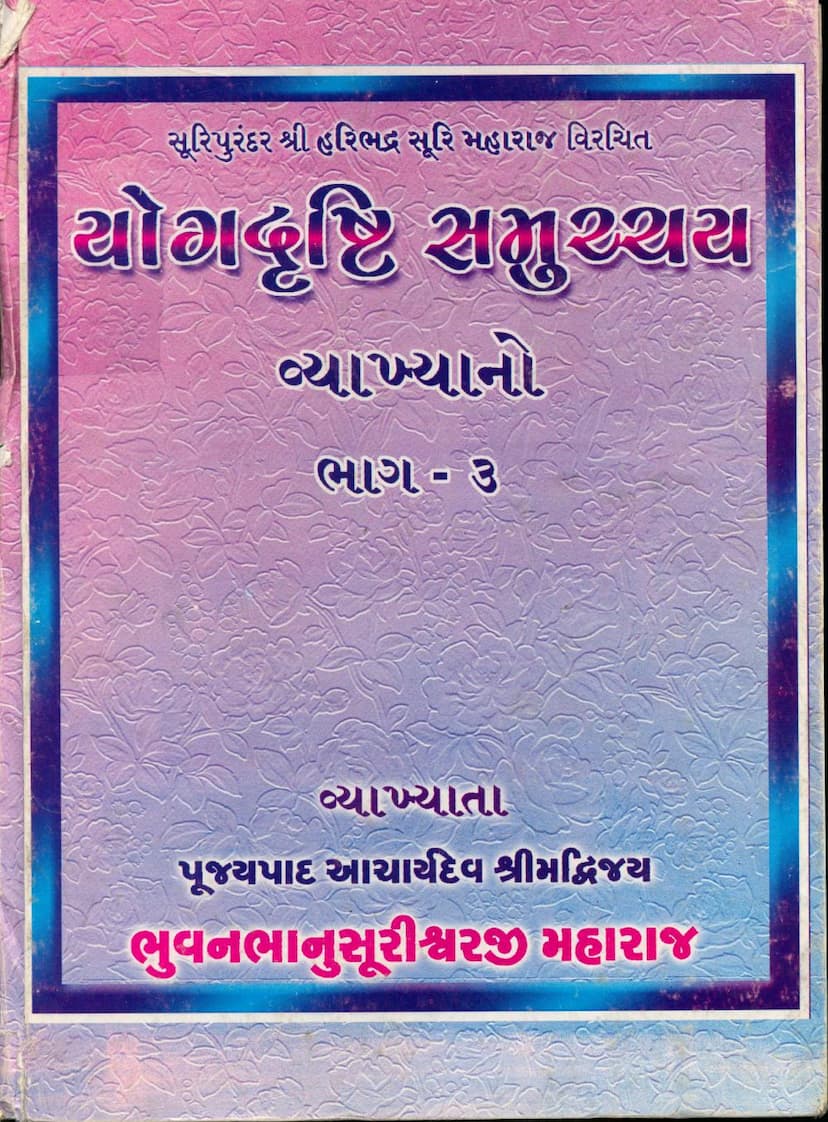Yogdrushti Samucchay Part 03
Added to library: September 2, 2025

Summary
Here's a comprehensive summary of the Jain text "Yogdrushti Samucchay Part 03" based on the provided pages:
Title: Yogdrushti Samucchay Part 03 (Commentary on Yogdrushti Samucchay) Original Author: Acharya Shree Hemchandrasuri Maharaj (revered as the author of 1444 scriptures) Commentator (Vyakhyata): Pujyapada Acharyadev Shree Vijay Bhuvan Bhanusurishwarji Maharaj Researcher: Pujya Pannyas Pravar Shree Jayasundar Vijayji Ganivar Maharaj Editor: Pujya Pannyas Shree Ajitsekhar Vijayji Ganivar Maharaj Publisher: Divyadarshan Trust First Edition: 2056 Vikramsavat (commemorating the Suri Prem Deeksha Centennial Year) Price: 100 INR
Overview:
This volume, the third part of the commentary, delves into the profound teachings of Acharya Hemchandrasuri Maharaj's seminal work, "Yogdrushti Samucchay." The commentary is presented by Acharya Shree Vijay Bhuvan Bhanusurishwarji Maharaj, renowned for his deep scholarship in Jain philosophy and his ability to elucidate complex spiritual concepts. This part continues the detailed explanation of the original text, building upon the previous two volumes.
Key Themes and Content:
The text is a detailed exposition of Jain philosophy, particularly focusing on the concept of "Yoga" from a Jain perspective, as articulated by Acharya Hemchandrasuri. It emphasizes the unique Jain approach to understanding the multifaceted nature of reality and spiritual practice, contrasting it with other philosophical schools.
- Reaffirmation of Jain Principles: The commentary strongly uphms the core Jain tenets of Syadvada (conditional predication) and Anekantavada (non-absolutism) as the highest principles within Jainism. It asserts that any belief contradicting these, however seemingly scriptural, is ultimately a fabrication contrary to the true scriptures.
- Emphasis on Logic and Reason: The text highlights the Jain principle of "Yuktim Vachanam Grhyam" (accepting a statement if it is logical) and the importance of reasoning in understanding spiritual truths, even going beyond the sayings of the omniscient (Sarvajna).
- Yoga from a Jain Perspective: The commentary explains that while the concept of "Yoga" exists in other traditions (mentioning Patanjali Yoga as a prominent example), Jainism's understanding is subtler. Jain yoga is deeply interwoven with Syadvada and Anekantavada. The text identifies "Yogdrushti Samucchay" as a unique Jain treatise on yoga that elucidates eight types of spiritual perspectives (drishti) to understand the different stages of a spiritual aspirant's journey. It aims to reconnect the threads of yogic knowledge that might have become separated from its Jain roots, making it accessible even to non-Jain scholars.
- The Significance of Acharya Hemchandrasuri: The work consistently praises Acharya Hemchandrasuri Maharaj for his profound intellect, his deep study of Vedic and Buddhist scriptures before his Jain renunciation, and his unparalleled contribution to Jain literature through works like "Anekant Jaypataka," "Shastra Vartasamucchaya," and "Dhurvachayan," which stand as testaments to his genius. The author of the commentary emphasizes that only someone with a deep understanding of various Jain scriptures and texts can truly do justice to Hemchandrasuri's yogic works.
- The Role of the Commentator and Editor: The preface acknowledges the immense contribution of Acharya Bhuvan Bhanusurishwarji Maharaj for his insightful lectures on "Yogdrushti Samucchay," which formed the basis of this commentary. It also specifically commends Panyas Shree Ajitsekhar Vijayji for undertaking the immense task of editing the remaining lectures and completing the work, particularly the commentary on the final fifty verses. The effort of researcher Panyas Shree Jayasundar Vijayji in verifying and refining the text is also highlighted.
- In-depth Analysis of Yogic Principles: The volume likely elaborates on specific yogic concepts as interpreted through the Jain lens. The detailed index provided on page 11 onwards suggests a methodical exploration of various aspects of yoga, including:
- Pranayama (breath control) in both material and spiritual forms.
- The impact of yogic practices on spiritual development.
- The importance of studying scriptures and the role of a Guru.
- Concepts like 'Sukshma Bodha' (subtle understanding), differentiating between true and false perceptions.
- The nature of the soul, knowledge, and the ultimate goal of liberation (Moksha).
- Detailed discussions on various philosophical viewpoints and refutations of incorrect ones through the lens of Jain logic.
- The text likely uses verses from the original "Yogdrushti Samucchay" as a basis for the commentary, explaining each verse in detail. The index shows a progression through different "drishtis" (perspectives) related to yoga, starting from Dipta Drishti (luminous vision) and moving through various stages of spiritual insight.
Structure and Content Breakdown (based on Index and Prefaces):
- Pages 1-3: Introduction, acknowledging the original author, commentator, editor, researcher, publisher, and the significance of this third volume.
- Pages 4-9: Preface and introductory remarks by the researcher and editor, providing context about Acharya Hemchandrasuri's work and the commentary's purpose. It emphasizes the importance of Jain philosophy's core principles and how this commentary serves to bridge the understanding of yoga across different traditions from a Jain perspective. It also details the editorial process and acknowledges contributors.
- Pages 10-13: Table of Contents, indicating the detailed subject matter covered in the volume, spanning from 'Deepra Pranayama Yoga' to 'Para Drishti' and 'Samadhi.'
- Pages 14 onwards: The main body of the commentary, systematically explaining the "Yogdrushti Samucchay" from the perspective of Acharya Bhuvan Bhanusurishwarji Maharaj, likely verse by verse or section by section. The index lists numerous philosophical and practical concepts related to Jain yoga and spiritual discipline.
Overall Significance:
"Yogdrushti Samucchay Part 03" is a significant work within Jain literature, offering a deep and reasoned explanation of yogic philosophy from a classical Jain viewpoint. It highlights the interconnectedness of various spiritual practices and philosophical insights, emphasizing the clarity and comprehensiveness of Jain thought as expounded by Acharya Hemchandrasuri and illuminated by the scholarly commentary of Acharya Bhuvan Bhanusurishwarji. The text is a valuable resource for those seeking to understand Jainism's unique perspective on spiritual discipline and the path to liberation.